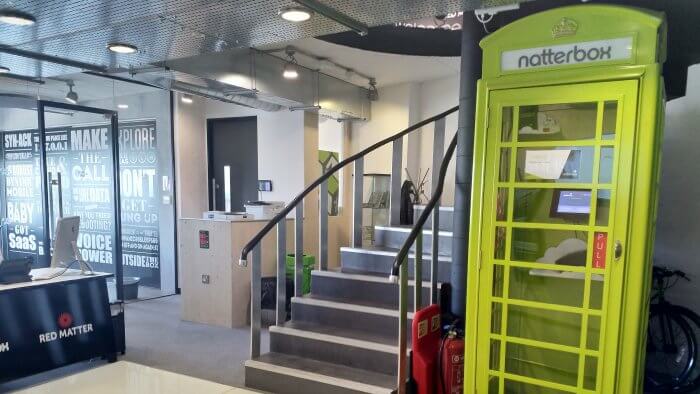Neil Hammerton, CEO Of Natterbox
The cloud telephony boss talks communications, good decision-making and nurturing talent.

Neil Hammerton is CEO and co-founder of Natterbox. He has been in IT for most of his working life. A serial entrepreneur, Neil began his career in security software sales, where he came to recognise the importance of listening to customer requirements and the value of working together to find a solution to a need.
What is Natterbox in a nutshell?
Natterbox is a cloud telephony platform entirely embedded within Salesforce, which allows companies to transform interactions with customers over the phone and provide them with a much more streamlined, informed and personalised experience.
As well as improving customer service experiences, our aim is to help businesses make the most of the insights and data generated by voice communications, which can provide invaluable insights that are vital to sales, product development and staff training.
Why did you decide to start the business?
I’ve spent most of my professional life working in IT. I began my career in security software sales, which is where I started to recognise the importance of listening to customer requirements. The idea of establishing Natterbox occurred to me when I realised how poorly the company I was working for dealt with incoming phone calls.
Despite having limited knowledge of the telecommunication sector at the time, my partners and I taught ourselves about the market with the help of an industry veteran and set up Natterbox to disrupt the traditional way of thinking about the telephone.
How did the business develop?
For a long time, the telephony industry has been dominated by on-premise and aimed at the enterprise space. Companies bring them on board to create bespoke, expensive solutions that come with associated redundancy and backup.
We founded Natterbox in 2010, hoping to change this traditional way of thinking about the telephone and the customer experience by embedding voice at the heart of business communications and development strategies.
When first founded, we built our own platform in-house and we’re currently the only company out there that provides a platform that sits directly within Salesforce. This means that Salesforce users can improve and transform their phone system without it becoming a massive infrastructure project - which is how most companies currently view telephone system upgrades.
Can you explain a little about current market conditions?
Telecommunications has very much taken a back seat within businesses when it comes to connecting and communicating with customers – today email, live chat or social media tend to be the preferred channels.
As a result, we’ve found that businesses are missing out on vital insights that can only be gathered through phone conversations and are missing the opportunity to give customers a personal, enjoyable and efficient experience over the phone.
We want to change this, and show businesses that, when implemented correctly, a telephone system is a vital tool in an organisation’s customer communication.

What has been your biggest challenge since starting Natterbox?
The challenges facing the telecoms industry are shifting every day, but one of the biggest we’ve faced is the ambiguous attitude of business to telecoms. In recent years it’s simply not been something that they believe they should invest in.
As previously mentioned, with the rise of social platforms and new technologies such as chatbots, the telephone has become somewhat a thing of the past for many businesses.
It’s therefore our job to show them the possibilities and benefits that voice and the telephone can provide as part of integrated, data-driven and customer-centric communications, perception and relationship-building strategy.
Three to four years ago, the company was fighting the long-standing notion that voice technology was simply not good quality. Today, the effectiveness of our offering and the benefits it delivers is helping eradicate that obstacle. It’s also showing how a smart, software-based telephony system can act as a true sales enablement and training tool for sales and customer service teams.”
What has been your biggest mistake?
The biggest mistake an entrepreneur can make is being indecisive, particularly not making a decision because you’re worried about making a mistake. You’ll never get anywhere if you’re not willing to take the risk.”
What major bumps in the road have you had and how have you overcome them?
One of the biggest challenges that Natterbox faced arose in 2014, when the company was focusing all of its energy on compliant mobile voice recording, to align with the MIFID II reporting. MIFID II was an amended version of the Markets in Financial Instruments Directive, which was designed to offer greater protection for investors and inject more transparency into all asset classes.
At the time, the market looked like it was raring to go with this European directive. We were the only player in the market offering mobile voice recording integrated directly into the technology stack, instead of through a separate phone app.
The plan was for this service to become the fundamental revenue source moving forward – that is, until major banks lobbied governments to push MIFID II back by two years.
We found ourselves having to completely re-focus the business trajectory to move away from mobile voice recording and instead towards the CRM telephony market.
Growth stagnated for a while and the mobile voice recording arm of the business went from making up 60% of the revenue to representing only 10%. Positively, the risky change of focus to CRM telephony has been a success and now accounts for the other 90% of our business.
How do you aim to attract and retain good people?
A massive part of retaining the best talent is having an open and honest dialogue about performance and aspirations. Often though, the review process, where these conversations should take place, is poorly handled.
If you want a staff member to succeed, sometimes you have to be cruel to be kind – how can staff feel they are furthering their career if they’re not receiving honest feedback on how to improve? And when a member of staff isn’t quite ready for the next step, they need encouragement and considered feedback that they can act on and feel inspired by to achieve their goals.
A simple “keep doing what you’re doing” just doesn’t cut it in these situations. We’re not at school anymore – staff get better job satisfaction from proper, actionable feedback and that’s what will ensure they stay loyal to a business in these uncertain times.
Ultimately, people are like sponges – they learn quickly if they are bright and given the opportunity. The problem is that they can be missed if management fail to nurture them in the right direction. If businesses want to uphold their reputation for talent retention and mitigate the risk of being understaffed, they need to put appropriate processes in place in order to maintain staff satisfaction.
When it comes to staff, happiness comes first, and that’s the approach we take at Natterbox.
What is your best advice to would-be entrepreneurs?
If you have an idea, give it a go. Don’t be scared to make mistakes. The worst that can happen is that it doesn’t work, but then you just try again! If you’re prepared to work hard and put the effort in, then you’ll be alright.
Thanks for signing up to Minutehack alerts.
Brilliant editorials heading your way soon.
Okay, Thanks!